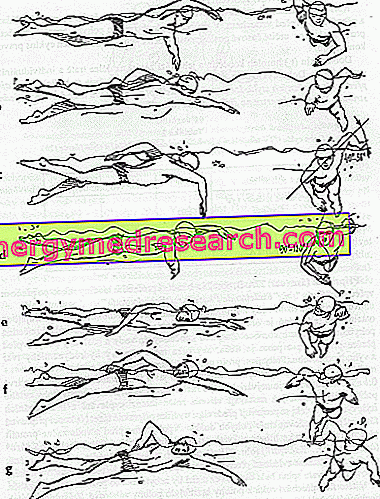The crawl provides alternating and cyclic movements of the upper and lower limbs; on the action of the arms a lateral type of respiration is inserted, which can be performed on one side only, or alternatively on the right and on the left (normally every 3 strokes you breathe; NB. When you come out with your face to breathe, you need to keep the respective shoulder as an optical reference point, so as to avoid raising the head excessively by slowing down the swim).
The position assumed, both in prone and supine floating, is conditioned by the lower limbs, whose mass constitutes about 40% of all body weight. While, in fact, the upper part, thanks to the floating bag of the lungs, remains rather raised, the legs tend to fall. This sinking occurs to a greater or lesser extent depending on the specific weight, which, if it favors the lighter, certainly creates some problems for those whose limbs are made heavy by a skeleton and by a remarkable musculature.
The thrust of the foot also receives an upward response from the water (as well as forward) useful for the floating of both the limbs and the whole body, thus favoring a more elevated position and a better hydrodynamic attitude.
The best position for advancing in the water is that which allows the swimmer to remain horizontal and as high as possible; this allows to minimize the resistance offered by the water.
The propulsion of the lower limbs, together with the action produced by the arms in the support phase, allows the whole body to rise, making the swimmer assume a more hydrodynamic position, through which he can "slide" better.
DATA SHEET
Movement
Alternating and cyclical
Body position
prone; in sprints the body tends to be well lifted and almost glides over the water; in the long distances, instead, it remains a little more immersed.
Upper limbs movement :
1) aerial action 2) underwater action
The aerial action has two functions:
a) carry forward the limb
b) muscle refreshment
The aerial movement, if carried out with flexed elbow, reduces the lateral movements of the pelvis and lower limbs; guarantees greater energy recovery
Underwater action
It is distinguished in: support / grip, traction and thrust. The action is always active, albeit with a different result in the progress, depending on how the hand directs the thrusts.
The action of the hand develops along a curvilinear trajectory (to take advantage of the upward thrust; to find firmer water by changing the direction in which the force is applied; to apply force longer.
At the end of the support / grip phase the arm flexes at the elbow to take advantage of a more advantageous lever and to develop an action (if viewed from the side) more parallel to the progress line
The elbow in the pulling phase must be high compared to the hand; targets:
- make the hand itself a useful vogatory action (Bernoulli)
- Also wrap the forearm in the push towards the back.
Breathing
Every single cycle is inserted into the arms, after several complete cycles, or to the right or left every 3 ... 5 ... strokes.
The swimmer must exhale completely under water, making sure:
- to respect a moment of waiting, to stay longer with full lungs
- to delay the rotation of the head for a better hydrodynamic attitude.
Lower limbs movement
The useful phase develops in the movement from top to bottom
The whole limb is involved in the movement, from the hip to the feet
The action takes place completely underwater
The depth varies from 20 to 40 cm
The leg flexion on the thigh can be up to 110/120 degrees
The foot in the descending phase must be naturally extended and rotated inward for better thrust.
Relationship of upper limbs and lower limbs
1) 1 cycle / 6 beats of legs:
- the position one tends to assume is the most hydrodynamic that can be achieved in swimming, even if very expensive due to the intense action of the legs
- the latter perform a mainly propulsive action
- the underwater action of the arms is very wide to allow the insertion of the six bars - the air action must be at an elbow flexed
- properly delayed breathing is very well suited to this type of crawl
2) 1 cycle / 2 beats of legs:
- you swim more in the water, so the body is less hydrodynamic than the previous interpretation
- increases the stabilizing function of the lower limbs
- the underwater action of the arms is reduced in amplitude and has a greater frequency; air action tends to be faster and less flexed
3) 1 cycle / 4 beats of legs:
- intermediate situation between 1) and 2).

//jiri.patera.name/html/uk/entertain.html
Edited by: Lorenzo Boscariol



